

Curious Kids: why do leaves change colour? Curious Kids is a series for children of all ages, where The Conversation asks experts to answer questions from kids.

All questions are welcome: find out how to enter at the bottom of this article. Why do leaves change colour in autumn? – Isaac, age eight, Guildford, UK Hi Issac, this is a really interesting question and something that lots of people wonder about when the seasons change. In the autumn, lots of plants (especially trees) throw away their leaves. These are great for jumping in, but why do some plants do this? For plants to grow, they need sunlight, nutrients and water. Image of leaves chromatography. Why Does a Leaf Change Color? Fall Science Activities for Children - Leaf Chromatography. Why do leaves change color? - Science for Kids. Leaf Chromatography STEM Activity: Remove Color from Leaves! Broccoli colour changes and cancer-fighting compounds. Click to enlarge Broccoli, like other green vegetables, gets greener when you start cooking it.
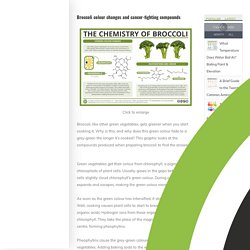
Why is this, and why does this green colour fade to a grey-green the longer it’s cooked? This graphic looks at the compounds produced when preparing broccoli to find the answer. Green vegetables get their colour from chlorophyll, a pigment in the chloroplasts of plant cells. Usually, gases in the gaps between plant cells slightly cloud chlorophyll’s green colour. As soon as the green colour has intensified, it starts to fade. Pheophytins cause the grey-green colouration of overcooked green vegetables. Chlorophyll isn’t the only compound we don’t want to destroy when cooking broccoli. When you chop broccoli, you release an enzyme called myrosinase from the plant cells. Sulforaphane interests scientists, as studies have shown it can kill some types of cancer cells. How you cook broccoli affects the amount of sulforaphane present. These compounds include hydrogen sulfide and dimethyl sulfide.
Leaf Color Chromatography - Bite Sci-zed. Why do leaves change colour in autumn. Chromatography: Why Do Leaves Change Colors? Why Do Leaves Change Colors? Why Do Autumn Leaves Change Color? - Instant Egghead #51. The Chemistry of Autumn Colors. Every autumn across the Northern Hemisphere, diminishing daylight hours and falling temperatures induce trees to prepare for winter.
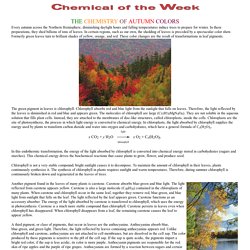
In these preparations, they shed billions of tons of leaves. In certain regions, such as our own, the shedding of leaves is preceded by a spectacular color show. Formerly green leaves turn to brilliant shades of yellow, orange, and red. These color changes are the result of transformations in leaf pigments. The green pigment in leaves is chlorophyll.
In this endothermic transformation, the energy of the light absorbed by chlorophyll is converted into chemical energy stored in carbohydrates (sugars and starches). Chlorophyll is not a very stable compound; bright sunlight causes it to decompose. UCSB Science Line - Kids Ask, Scientists Answer. Answer 4: I'm a little confused about your question.
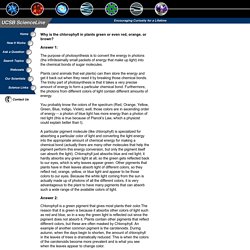
Chlorophyll pigment is always green. Plant leaves and stems aren't always green because they have many pigments other than chlorophyll. Pigments are molecules that absorb specific colors of light and reflect other colors, depending on their chemical structure. The reflected colors are what give pigments their color. Chlorophyll. Animation depicting nearly four years worth of SeaWiFS ocean chlorophyll concentration.
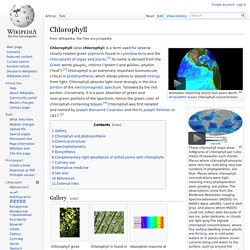
These chlorophyll maps show milligrams of chlorophyll per cubic meter of seawater each month. Places where chlorophyll amounts were very low, indicating very low numbers of phytoplankton, are blue. Places where chlorophyll concentrations were high, meaning many phytoplankton were growing, are yellow. The observations come from the Moderate Resolution Imaging Spectroradiometer (MODIS) on NASA’s Aqua satellite.
Land is dark gray, and places where MODIS could not collect data because of sea ice, polar darkness, or clouds are light gray.The highest chlorophyll concentrations, where tiny surface-dwelling ocean plants are thriving, are in cold polar waters or in places where ocean currents bring cold water to the surface, such as around the equator and along the shores of continents. Gallery[edit] Chlorophyll and photosynthesis[edit] Chemical structure[edit] Flavylium. Properties computed automatically from the given chemical structure Molecular Weight: Molecular weight or molecular mass refers to the mass of a molecule.
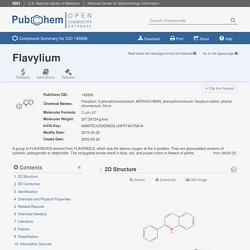
It is calculated as the sum of the mass of each constituent atom multiplied by the number of atoms of that element in the molecular formula. Molecular Formula: A chemical formula is a way of expressing information about the proportions of atoms that constitute a particular chemical compound, using a single line of chemical element symbols, numbers. Hydrogen Bond Donor Count: Hydrogen Bond Donor count Hydrogen Bond Acceptor Count: Hydrogen Bond Acceptor count. Flavylium. Photosynthesis. Activity Detail. Why Do Leaves Change Color and Fall? The Chemicals Behind the Colours of Autumn Leaves. Click to enlarge With autumn looming on the horizon, the leaves on some trees have already begun the transition towards the vibrant hues of autumn.
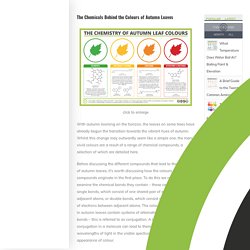
Whilst this change may outwardly seem like a simple one, the many vivid colours are a result of a range of chemical compounds, a selection of which are detailed here. Before discussing the different compounds that lead to the colours of autumn leaves, it’s worth discussing how the colours of these compounds originate in the first place. To do this we need to examine the chemical bonds they contain – these can be either single bonds, which consist of one shared pair of electrons between adjacent atoms, or double bonds, which consist of two shared pairs of electrons between adjacent atoms.
The colour causing molecules in autumn leaves contain systems of alternating double and single bonds – this is referred to as conjugation. Why do leaves change color in autumn? Tell Me Why Kids Video Show in 3D.